Featuring some of Europe’s most stunning beaches and islands and boasting a vast number of spectacular archaeological sites, there’s never a lack of reasons to visit Greece, but if there’s one that stands out, it’s the opportunity to taste one of the world’s most mouthwatering cuisines, one dish of the best Greek food at a time.
Jump to a section of this article
A Quick Overview of Greek Cuisine
With a focus on vegetables, grains, legumes, and fruit, the Mediterranean diet is a synonym for healthy eating. It’s inspired by the traditional dishes of Mediterranean countries, such as Italy, Spain, and of course, Greece. The best Greek food reflects the principles of Mediterranean cuisine in the most delicious way.
This plant-based approach to food has been a characteristic of Greek cuisine since ancient times. Dishes in Ancient Greece revolved around extra virgin olive oil, wheat, and wine, three ingredients that are still omnipresent throughout Greece and its regional cuisines.
Often nicknamed Greece’s Liquid Gold, extra virgin olive oil adds flavor to even the plainest dishes, turning them into culinary masterpieces. After all, the uniqueness of Greek cuisine lies in its very simplicity but also the top quality of the country’s fresh produce.
Speaking of flavor, another main feature of Greek cuisine is the use of dried herbs, such as oregano, thyme, or rosemary. At the crossroads of Europe and Asia, traditional Greek dishes also have their fair share of spices from the East, such as cumin or nutmeg.
Although relying heavily on vegetables and legumes, authentic Greek cuisine is also abundant in fresh fish and seafood caught in the waters of the Aegean Sea.
Traditionally, meat consumption was reserved for holidays and special occasions. However, this has now changed with modern Greeks eating quite a lot of meat, both white and red.
Cheese is also a staple of Greek cuisine. From north to south, Greece produces excellent and numerous types of cheese, with Feta, Kasseri, and Graviera being the most famous among them.
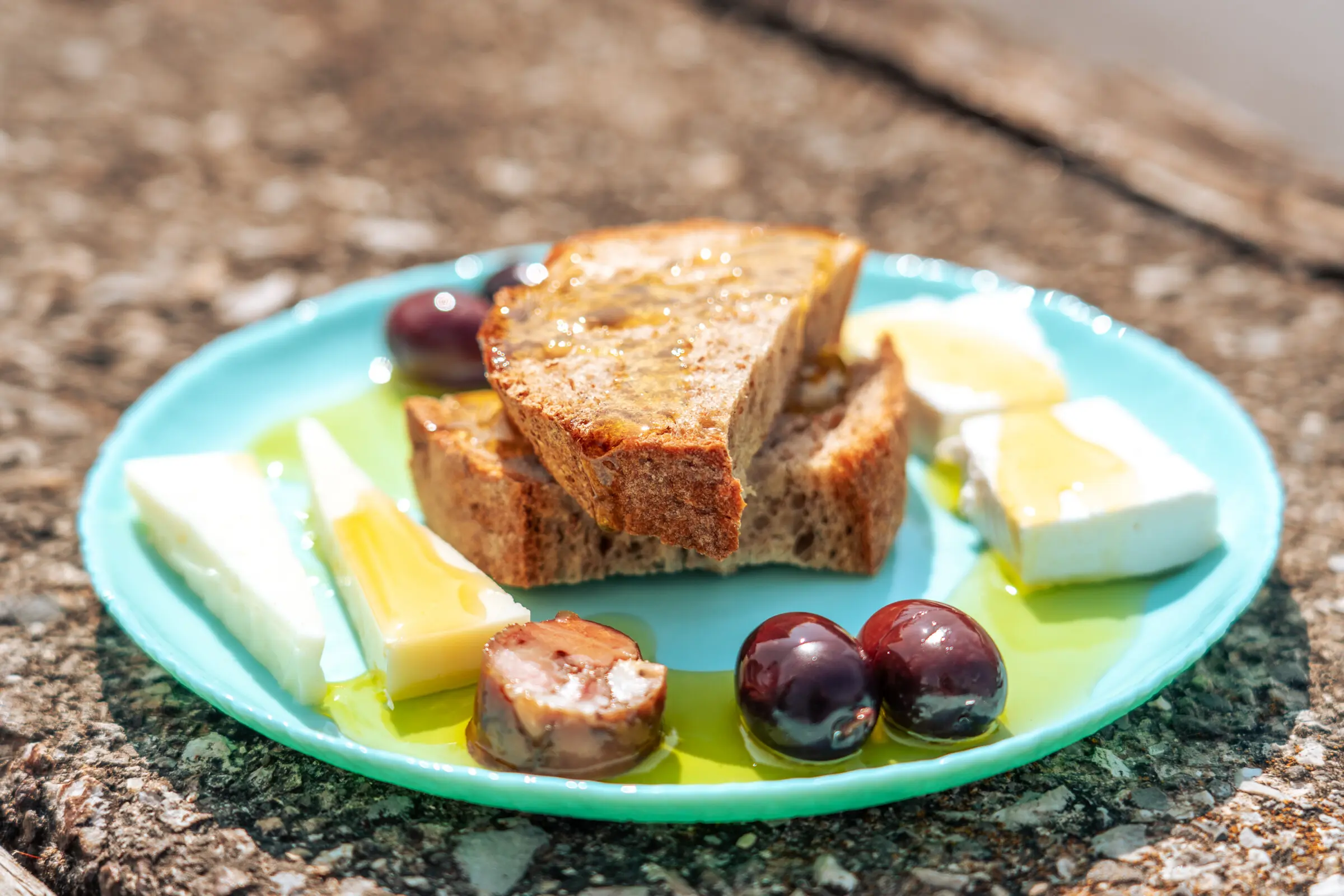
Dining Culture in Greece
Dining out in Greece is common, often resulting in a feast. At any taverna in Greece, the most delicious Greek dishes are served either as separate courses split between appetizers and mains or as Meze dishes for everyone to share over a few liters of house wine. If you want to dine like a local in Greece, sharing is the way to go.
But most importantly, to not stand out as a tourist in Greece, you should adapt to the locals’ dining times. Dinner in Greece rarely starts before 9 PM and this is why some of the best Greek restaurants are quite empty around 7 PM, which is dinner time in most other parts of the world.
But even if you can’t bring yourselves to eat that late, eating out in Greece is an experience not to be missed. The country’s traditional tavernas, but also its more refined restaurants, are shrines of deliciousness, good spirits, and socializing. Greeks love food and good company and eating out is their way of combining both.
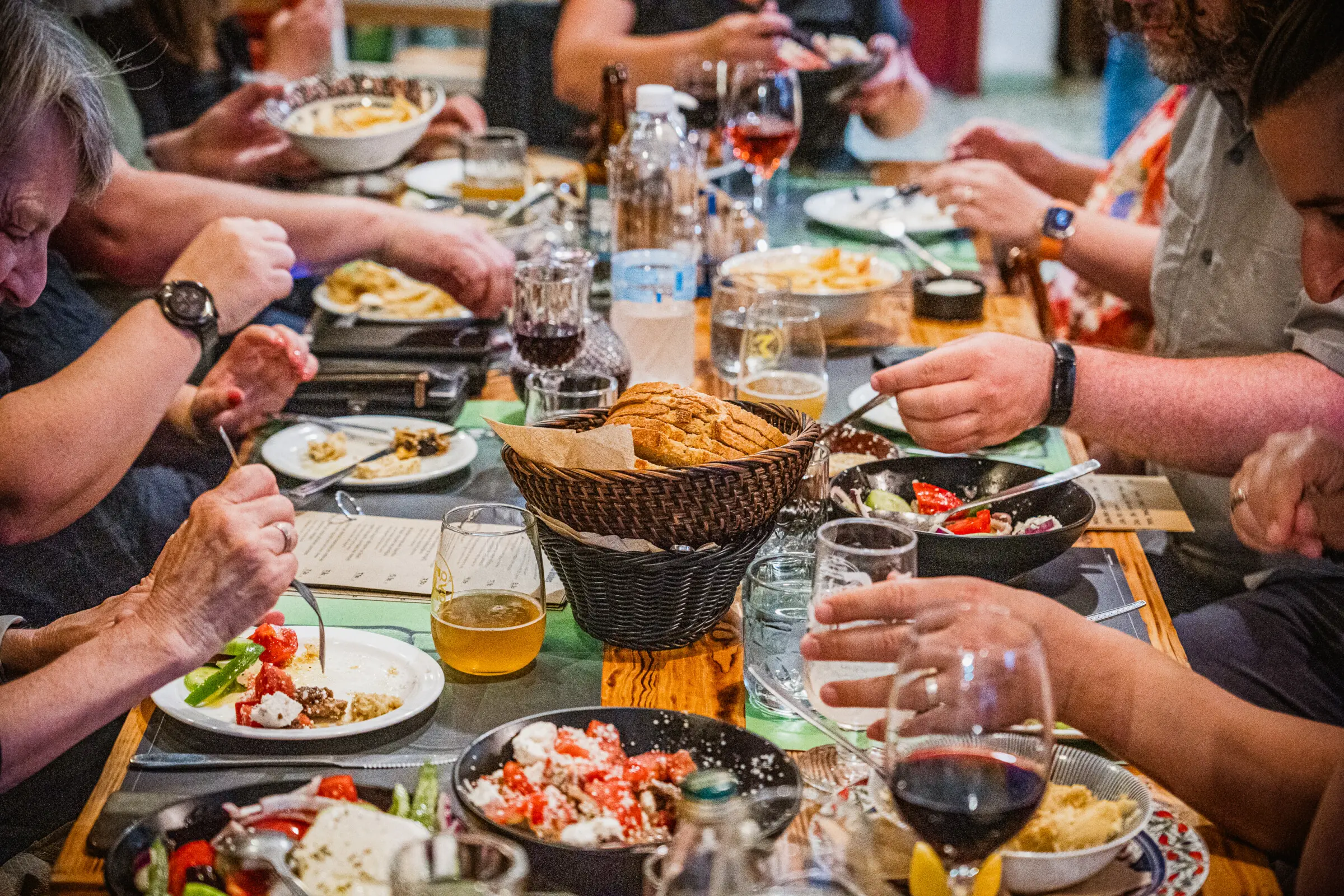
15 Best Dishes To Try in Greece
Greek cuisine is as diverse as Greece itself. There are countless authentic Greek dishes for all tastes and you can never go wrong with any of them. For the purposes of this article, we picked the 15 most popular dishes you have to try during your next trip to Greece.
Of course, they’re not the only ones. But it’d take volumes to write about all of them, so let’s start with the basics. Here’s our list of the best Greek food, curated by a local who loves good food, like all Greeks.
1. Greek Salad
In Greece, salad is served as a starter. However, it isn’t uncommon for the iconic Greek Salad to be ordered as the main course. A feast of color and unique flavor, Greek Salad is a staple of the country’s cuisine and never absent from any Greek household.
The fresh ingredients included in a Greek Salad are juicy ripe tomatoes, cucumbers, onions, and, of course, the indisputable queen of Greek Salad, a large piece of Feta Cheese.
Olives complete the list of main ingredients. But not just any olives. A good Greek Salad should always feature the delicious Kalamon or Kalamata Olives, a blessed fruit originating in the gorgeous region of the Peloponnese in Southern Greece.
Sometimes, green bell peppers are also added to a Greek Salad, which is seasoned with salt and dried oregano and doused in extra virgin olive oil.
The best way to enjoy your Greek Salad is by dipping freshly baked sourdough bread pieces into the bottom of the bowl, where all the goodness hides, as you nibble on the vegetables and Feta cheese. That’s how we Greeks do it and that’s how you should, too.

2. Tzatziki
Since we’re still on the starters, let’s talk about the classic Greek dip: Tzatziki. Easier to devour than pronounce, Tzatziki is made of top-quality Greek yogurt, chopped cucumbers, salt, olive oil, and garlic, lots of garlic. A dried herb is almost always added to the mix, usually mint, sometimes replaced by dill.
Tzatziki can be ordered as a starter at any Greek taverna to dip your other starters – like french fries or fried zucchini – into. It can also come as a side to flavorful meat dishes while it’s a main ingredient of the traditional Greek Souvlaki wrap. But more on the latter further down on this list of the best Greek food.
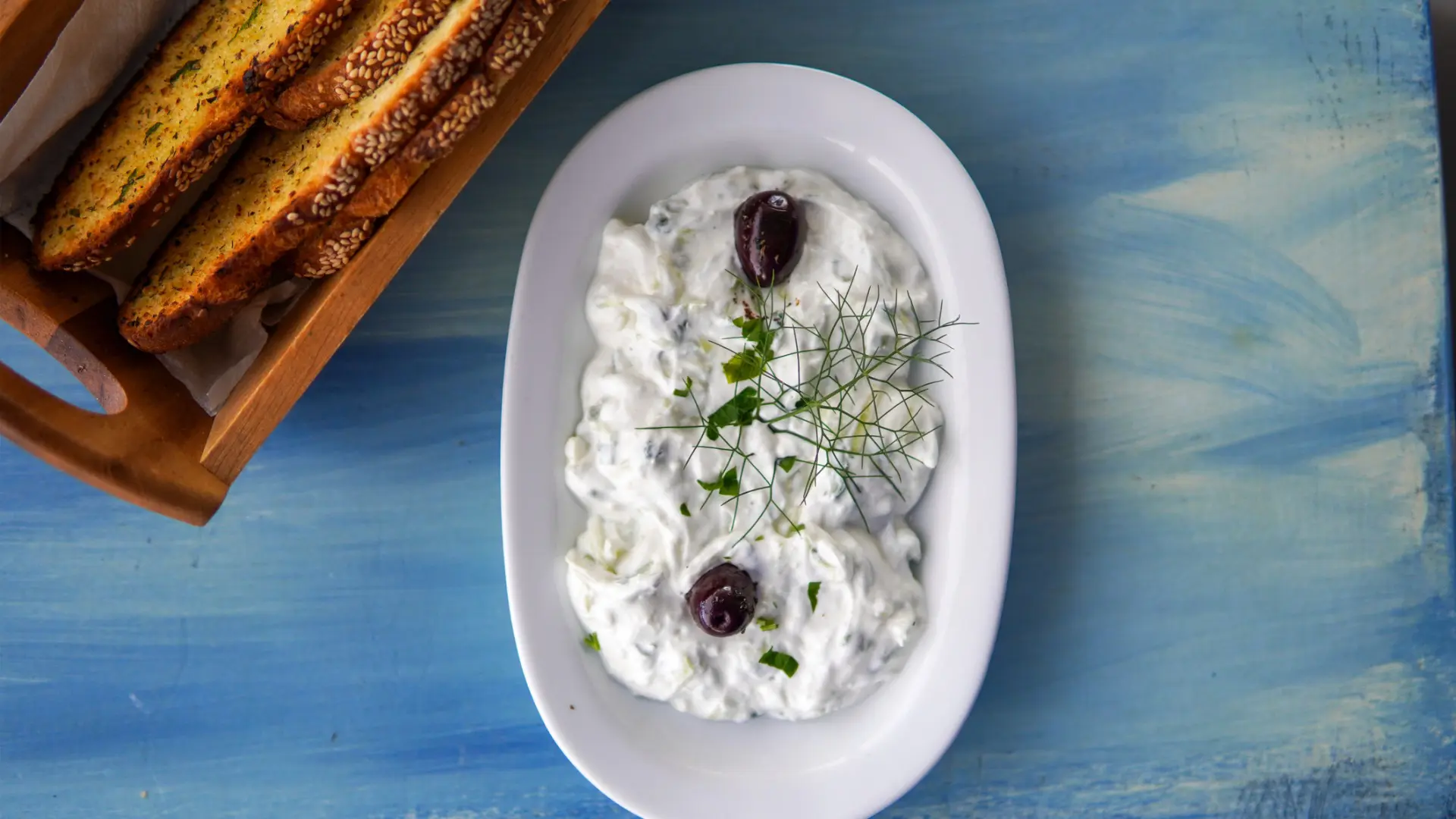
3. Saganaki Cheese
As we already mentioned, cheese is a staple of Greek cuisine. Apart from eating it fresh or mixed in salads, cheese can also be cooked to perfection to become the protagonist of several appetizers in Greece. The most popular – and delicious – among them is Saganaki.
Named after the pan it’s fried in – Saganaki is the Greek word for a small frying pan – this delectable Meze dish of fried cheese is a lot more interesting than it sounds, mainly because it’s made with top-quality Greek cheese, most often Graviera, Kasseri or Halloumi from Cyprus, then doused in fresh lemon juice while it’s still hot.
By the way, you shouldn’t leave your Saganaki Cheese lingering on the table as it becomes hard to chew when cold. Come to think of it, that won’t be a problem. Saganaki is so tasty that it disappears in a heartbeat.
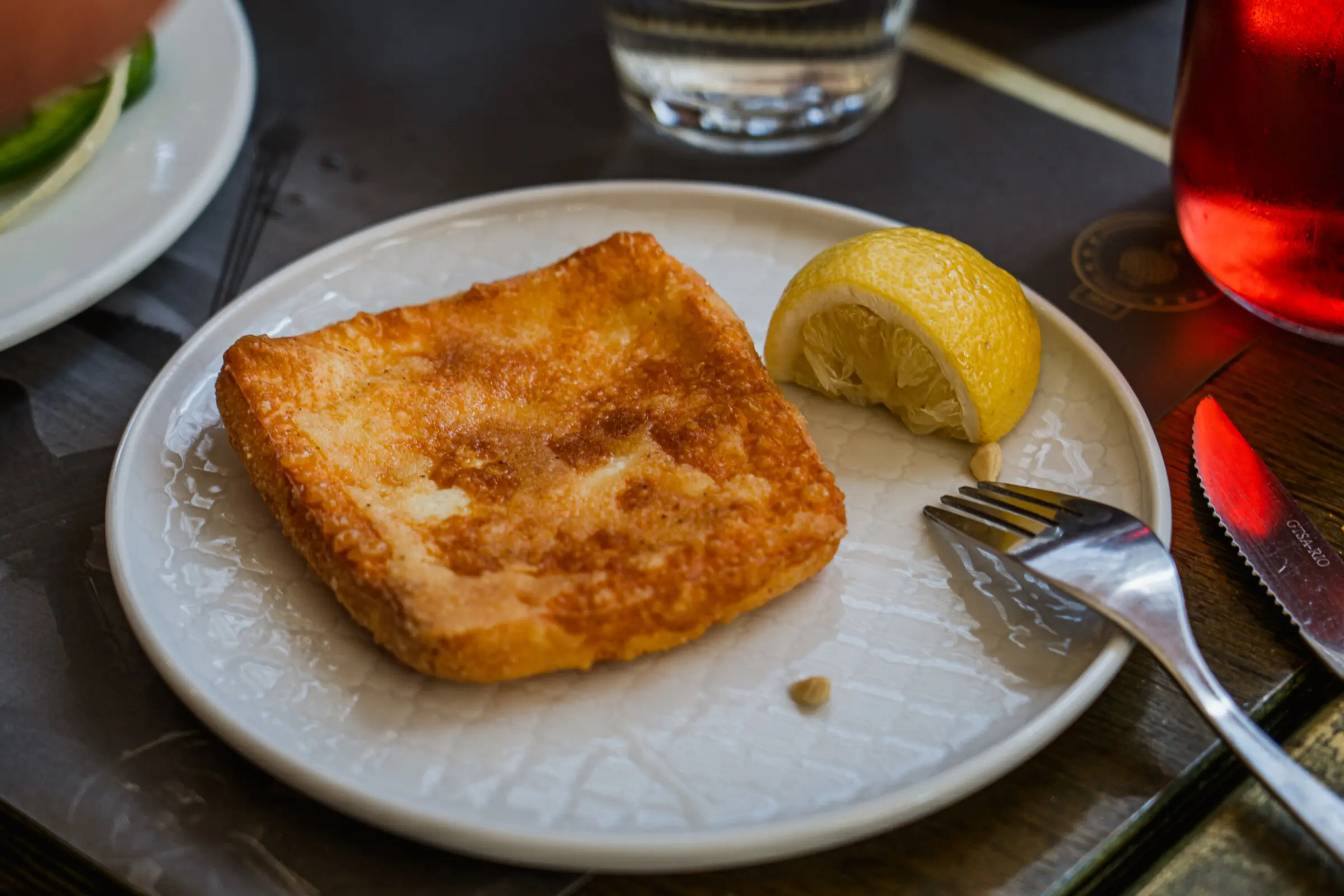
4. Cheese Pie
Fancy a bit more of cheese heaven? If you, like us Greeks, love cheese in all its forms, you simply can’t leave the country without trying as many versions of Greek cheese pie as possible.
Cheese pie is omnipresent in Greece. You can find individual-sized cheese pies at every single bakery or snack bar in Greece. Cheese pie is also a staple Meze dish at tavernas. However, in this case, you’re served a piece of a larger cheese pie rather than an individual one.
The Greek cheese pie is a pastry filled with a cheese and egg mixture. As hinted above though, there are many versions of Greek cheese pie, depending on the region you’re visiting.
The pastry can be anything from handmade thick phyllo dough to thin phyllo dough to puff pastry. The filling is almost always made with Feta Cheese but, sometimes, Kasseri or Graviera are used instead.
In some areas, dried herbs are added to the mixture, primarily mint. In most cases, the Greek cheese pie is oven-baked but some regional cuisines have a deep-fried variation.
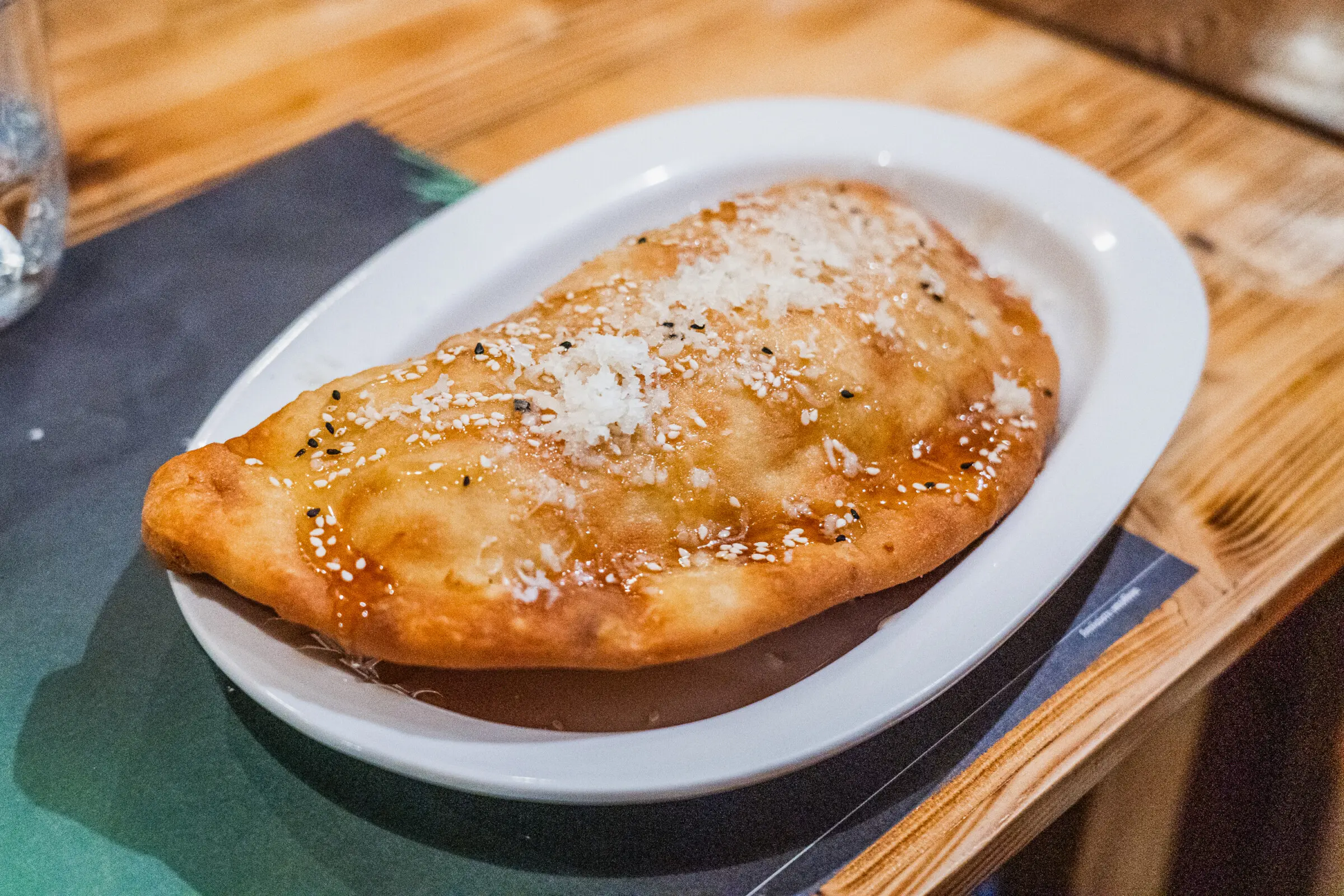
5. Spinach Pie
For many, a pie is the best Greek food to try, especially in Ioannina and the rest of the Epirus region. If you ask any Greek about their favorite Greek pie, the reply will most probably be unanimous: spinach pie.
This savory pie is featured in several cuisines throughout the Balkans. Yet, the Greek version is second to none. Fair enough, that’s coming from a Greek. But you have to trust us on this one.
As its name suggests, this pie is made of phyllo dough filled with spinach. Other ingredients include spring onions, dill, and, often, other greens, too. That’s the vegan version. There’s also a veggie version that features Feta cheese in the mix.
Like the cheese pie, Greek spinach pie can be found in every bakery across the country and served as an appetizer or Meze dish at traditional tavernas.
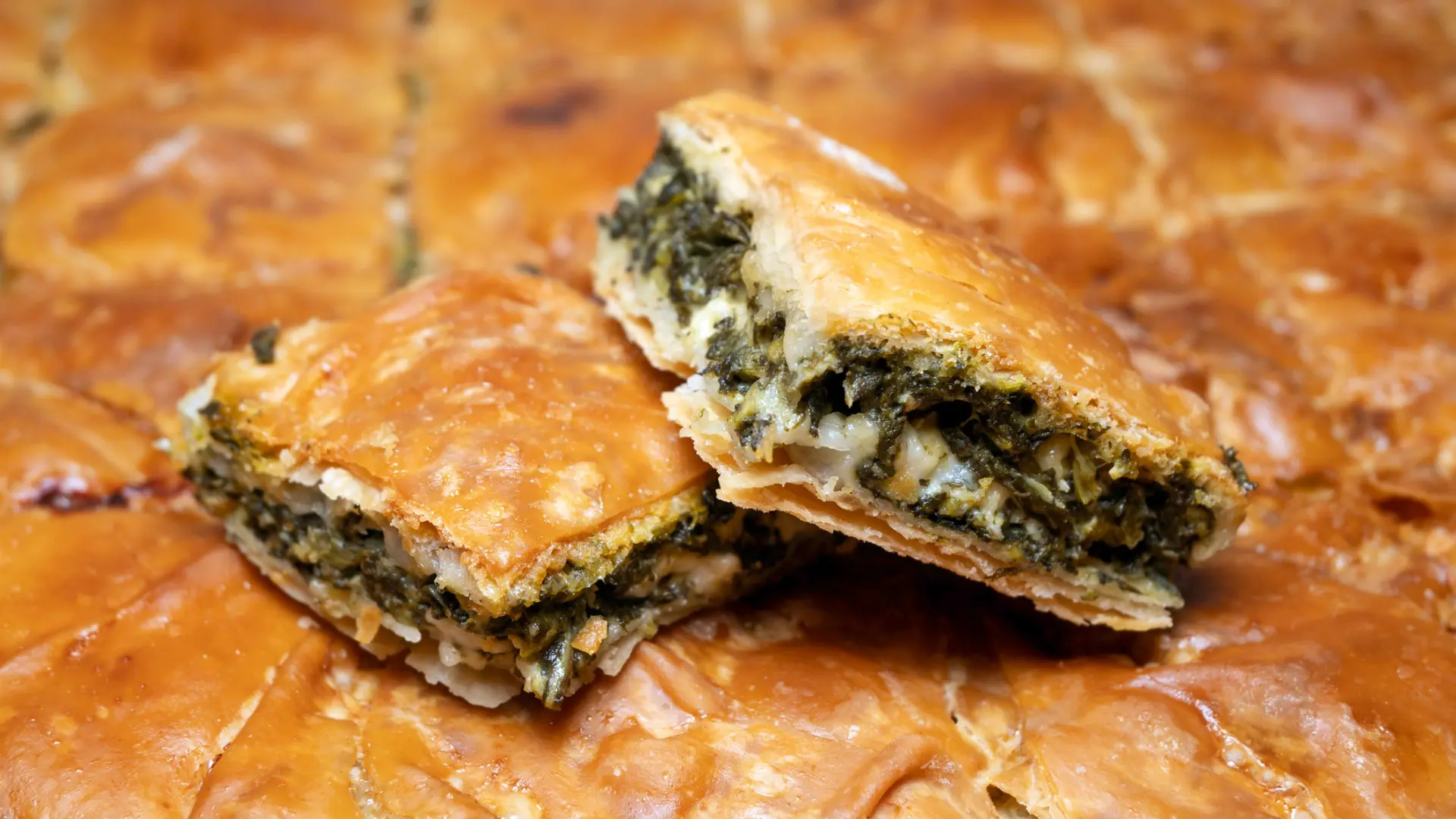
6. Souvlaki
The most popular Greek street food is no other than the world-famous Souvlaki. This mouthwatering fast food is also the source of the greatest debate – or confusion – of all time between Northern Greeks and Southern Greeks: is it Souvlaki, Kalamaki, or maybe Gyros? We’re here to – try – and explain it all to you.
Souvlaki is the Greek word for a small skewer. By extension, the meat pieces cooked on the skewer are known as Souvlaki, too. Ancient Greeks would cook meat on skewers as early as the Bronze Age.
Traditionally, a Souvlaki was made of pork meat but, now, chicken skewers are equally common. You can eat a Souvlaki either on its own or as part of a Pita wrap with tomatoes, potatoes, onions, and Tzatziki sauce.
Kalamaki is the Greek word for the small wooden stick the meat pieces are on. Let’s leave it at this for now.
Gyros or Gyro is the meat cooked on a giant vertical spit, kind of like the Turkish Doner. It’s then sliced and served wrapped in Pita bread, alongside tomatoes, potatoes, onions, and Tzatziki sauce. Like Souvlaki, either pork or chicken meat is used for Gyros. On very rare occasions, you may even find beef Gyros.
So, where’s the confusion? It all seems pretty straightforward, right? Well, here’s the thing. In Athens and Southern Greece, you ask for a Souvlaki if you want a Pita wrap, regardless of the meat that’s inside: either Souvlaki or Gyros. If you want just the meat on the stick, you ask for a Kalamaki.
In Thessaloniki and Northern Greece, you ask for a Souvlaki if you want the meat on the stick. If you want a wrap, you either ask for a Pita Gyros or Pita Souvlaki or a sandwich, which makes matters even worse because, then, your meat will be served in a plain bread roll rather than Pita bread.
The mother of all debates has been a source of mutual mockery between Southern and Northern Greeks for decades on end. As a guest, you won’t have a problem enjoying the Souvlaki version of your choice as long as you try to be as specific as possible.
War of words aside, Greek Souvlaki is probably the most emblematic of all dishes on this list of the best Greek food and your taste buds are in for a treat on your next trip to Greece.
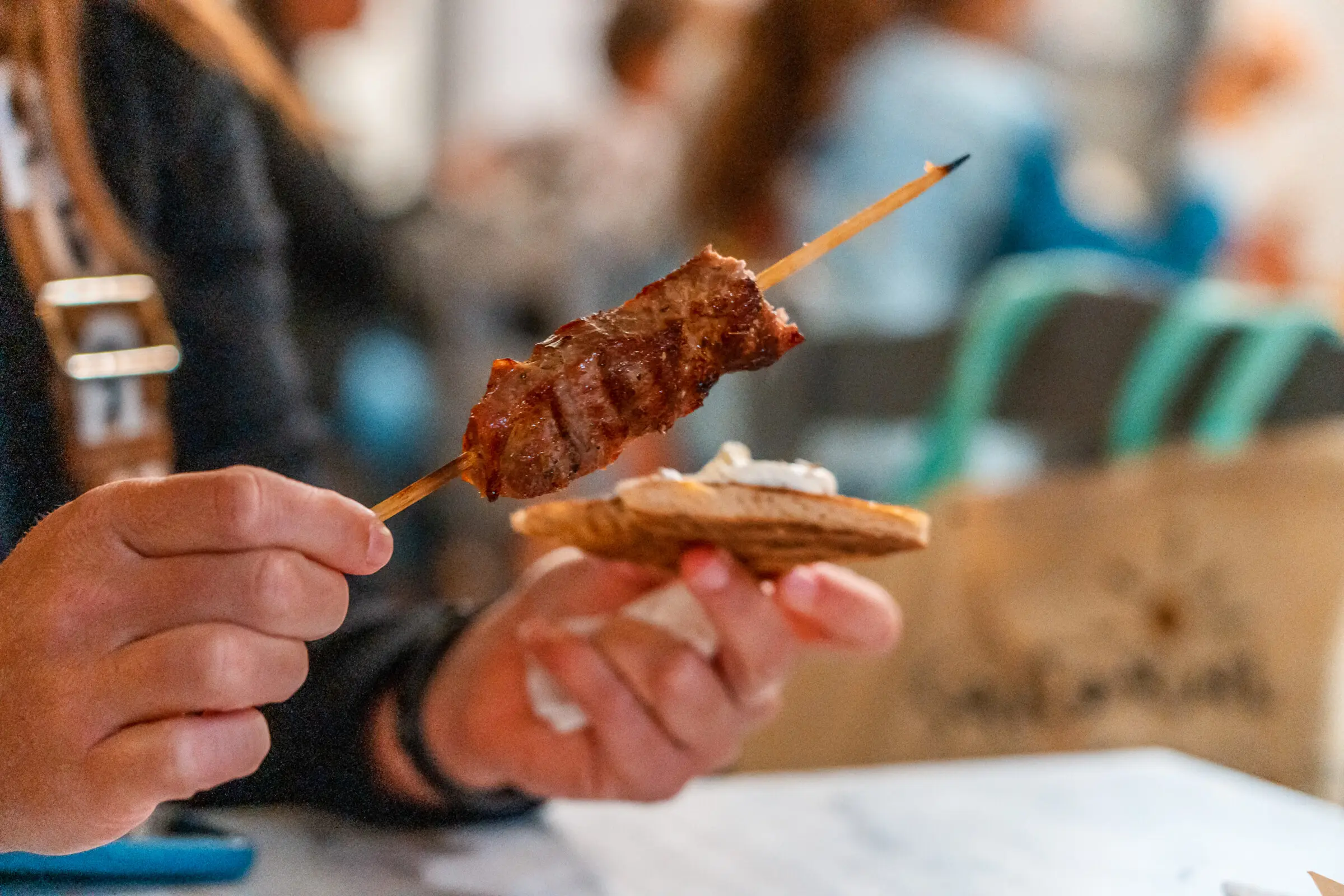
7. Pastitsio
Moving on to the main courses, Pastitsio is one of those dishes that Greeks can never say no to and is among their favorites for a Sunday lunch with friends and family.
With origins in similar recipes of Italian cuisine, Pastitsio is an oven-baked pasta dish that could be loosely referred to as Greek Lasagna. You can find Pastitsio at any traditional restaurant in Greece.
This hearty dish reveals its divine taste, one layer at a time. The bottom layer consists of tubular pasta. The middle layer is a rich ragu sauce made of ground beef meat, tomatoes, and spices, like cinnamon and cloves. It’s all topped with a thick Béchamel sauce and then baked in the oven until golden.
Pastitsio is usually served warm but it’s even better at room temperature.

8. Moussaka
Very similar to Pastitsio but with Balkan instead of Italian influences, Moussaka is a staple of traditional Greek food and a true symbol of Greek summer, thanks to the aromas of fresh eggplant, the dish’s main ingredient.
Yet another oven-baked delicacy, Moussaka consists of layers of fried potato slices, fried eggplant, ground beef in tomato sauce, and a creamy Béchamel sauce. Although it takes quite a bit of time to make, its taste is more than rewarding.
You can try this classic Greek dish at any traditional restaurant or taverna. When you order it as a main, try not to go crazy with appetizers because Moussaka is quite a heavy food.
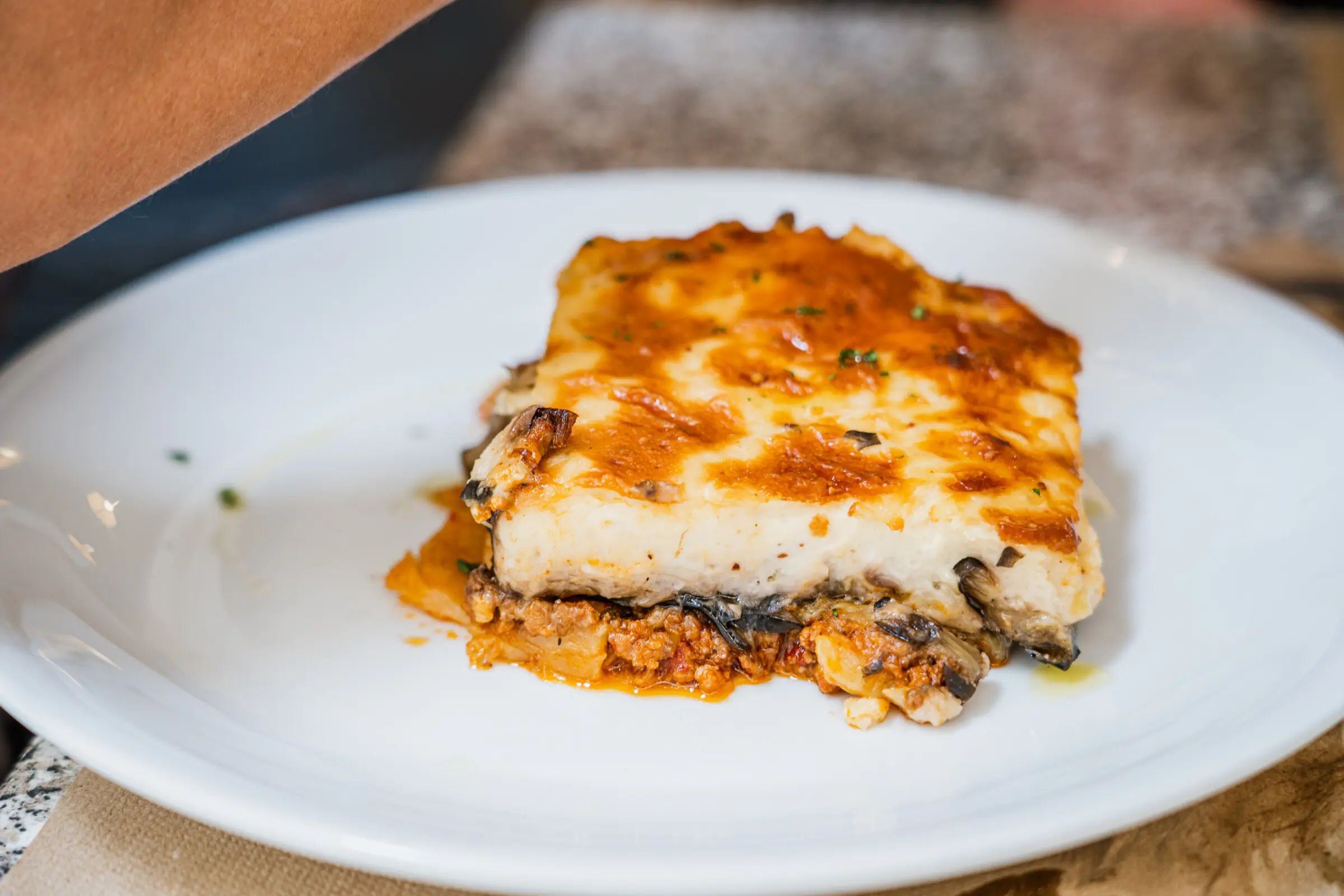
9. Greek Meatballs
In Greece, grandmothers tend to spoil their grandchildren by cooking their favorite dishes each and every time they ask for them. When it comes to childhood memories, most Greeks will tell you that the best Greek food is meatballs with french fries, the way their grandmothers used to make them.
Even if you don’t have a Greek grandma, you can savor equally luscious fried meatballs at any traditional restaurant across the country. Greek meatballs are made of ground beef meat, seasoned with parsley, mint, and onions. Once they’re out of the frying pan, fresh lemon juice is squeezed on top, for extra flavor.
Greek meatballs are a great match with freshly cut french fries and Greek salad or Tzatziki – or both – on the side.
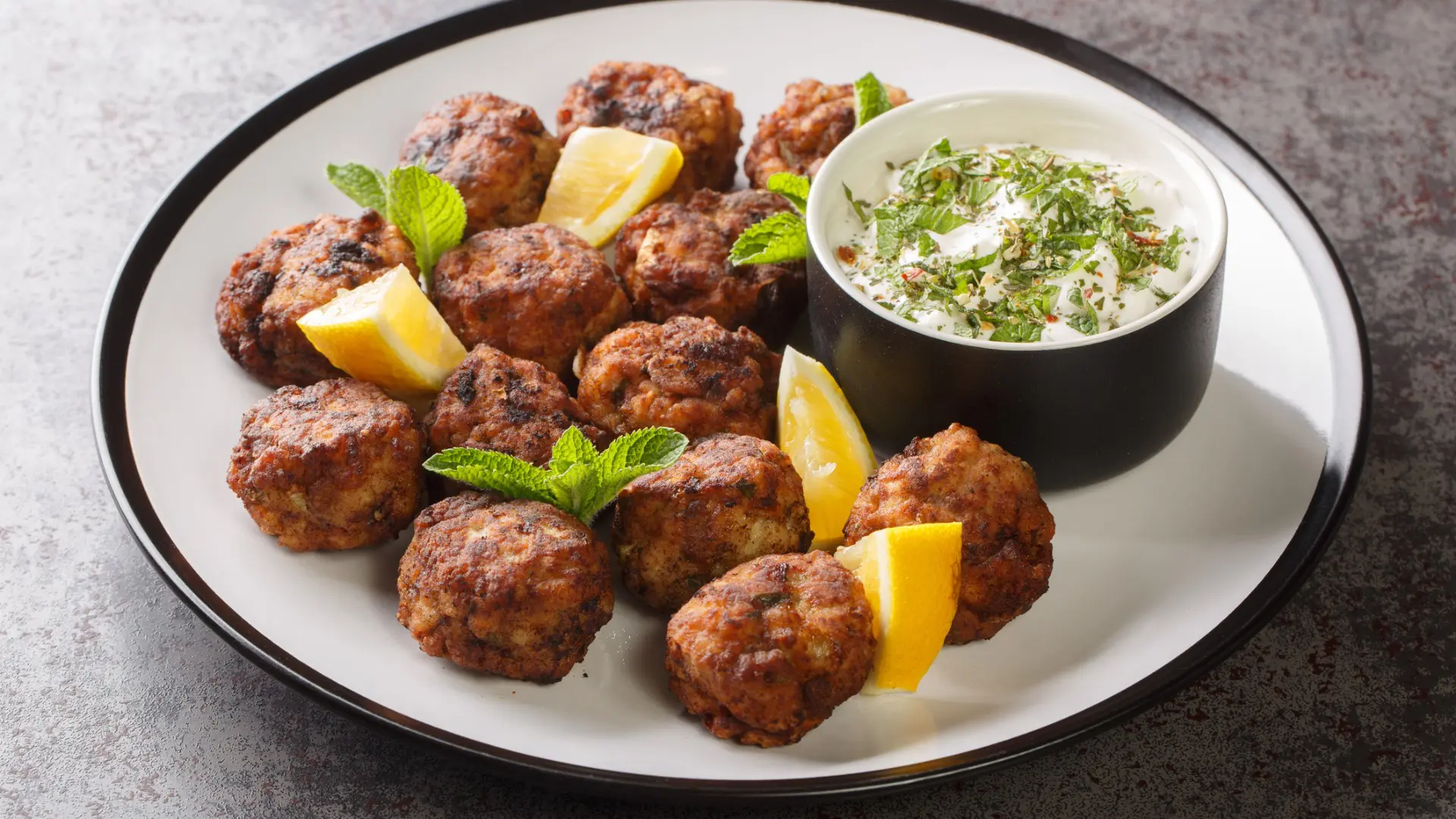
10. Fresh Fish
With so many islands and a coastline that stretches for several kilometers, Greece is renowned for its fresh fish and seafood. When in Greece, you can’t miss out on the opportunity to try freshly caught fish cooked in several ways.
Small fish, like anchovies or smelts, are usually fried in a plain flour batter, while sardines or larger types of fish, such as sea breams or sea basses, are almost always served grilled with a dressing of extra virgin olive oil, fresh lemon juice, and dried oregano.
In the past, fresh fish was the star of the table, leaving little to no room for other delicacies, save for some side dishes. However, nowadays, chefs in Greece use their creativity to come up with inspired recipes that blend fresh fish with other ingredients, such as pasta, rice, or fresh vegetables.
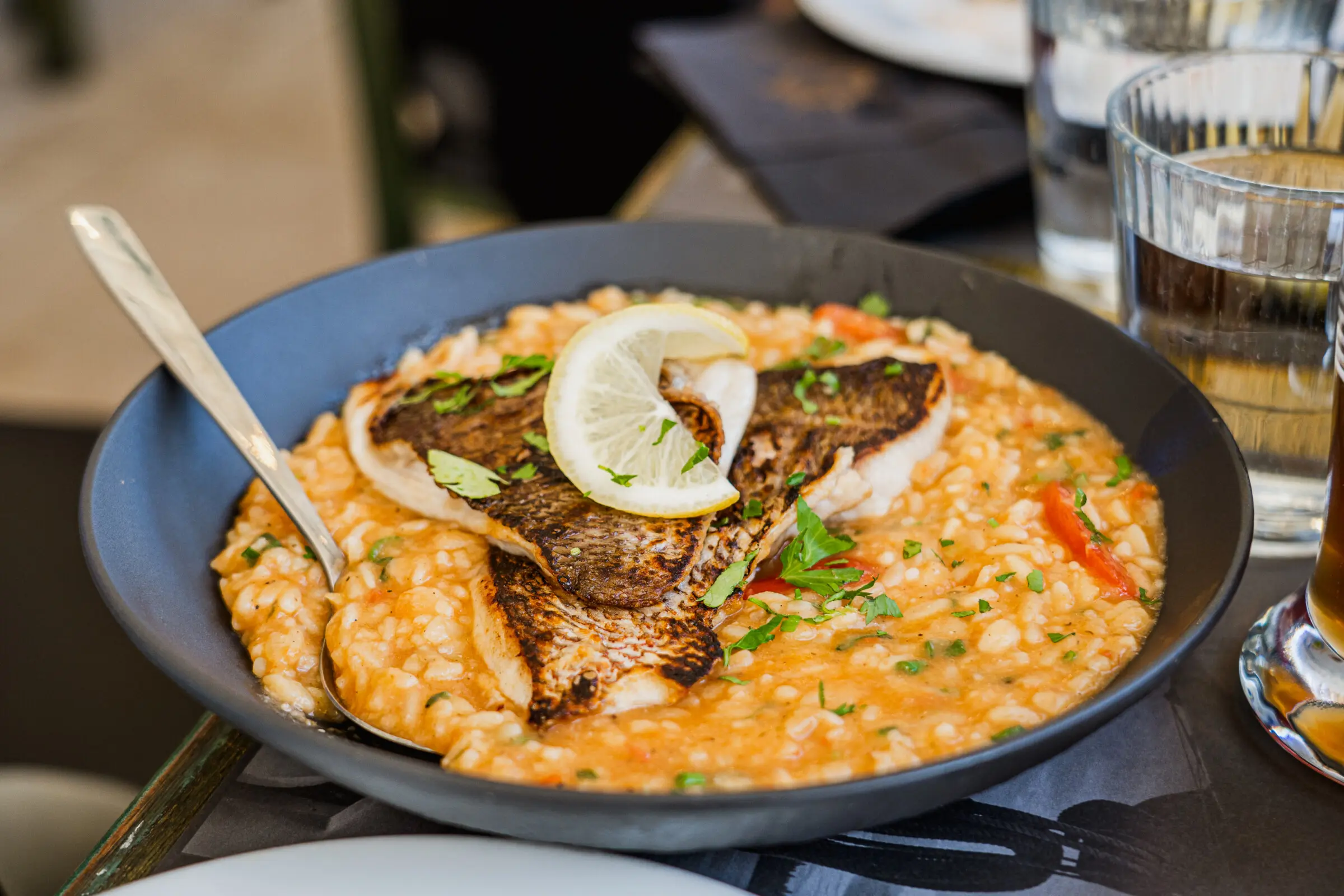
11. Grilled Octopus
Apart from fish, Greek cuisine abounds in fresh seafood, too. Greeks love to share small plates of seafood over a glass of wine or Tsipouro – Greece’s local spirit of choice.
From fried squid to steamed mussels to shrimp in tomato sauce, there’s a wide selection of seafood dishes to choose from. Yet, greatness lies in simplicity and the humble dish of grilled octopus doused in fresh lemon juice is everyone’s favorite.
If you ask any Greek the meaning of summer, they will tell you it’s sipping Ouzo by the sea, munching on small pieces of grilled octopus as they dip their toes in the sand. What’s stopping you from doing summer the Greek way?
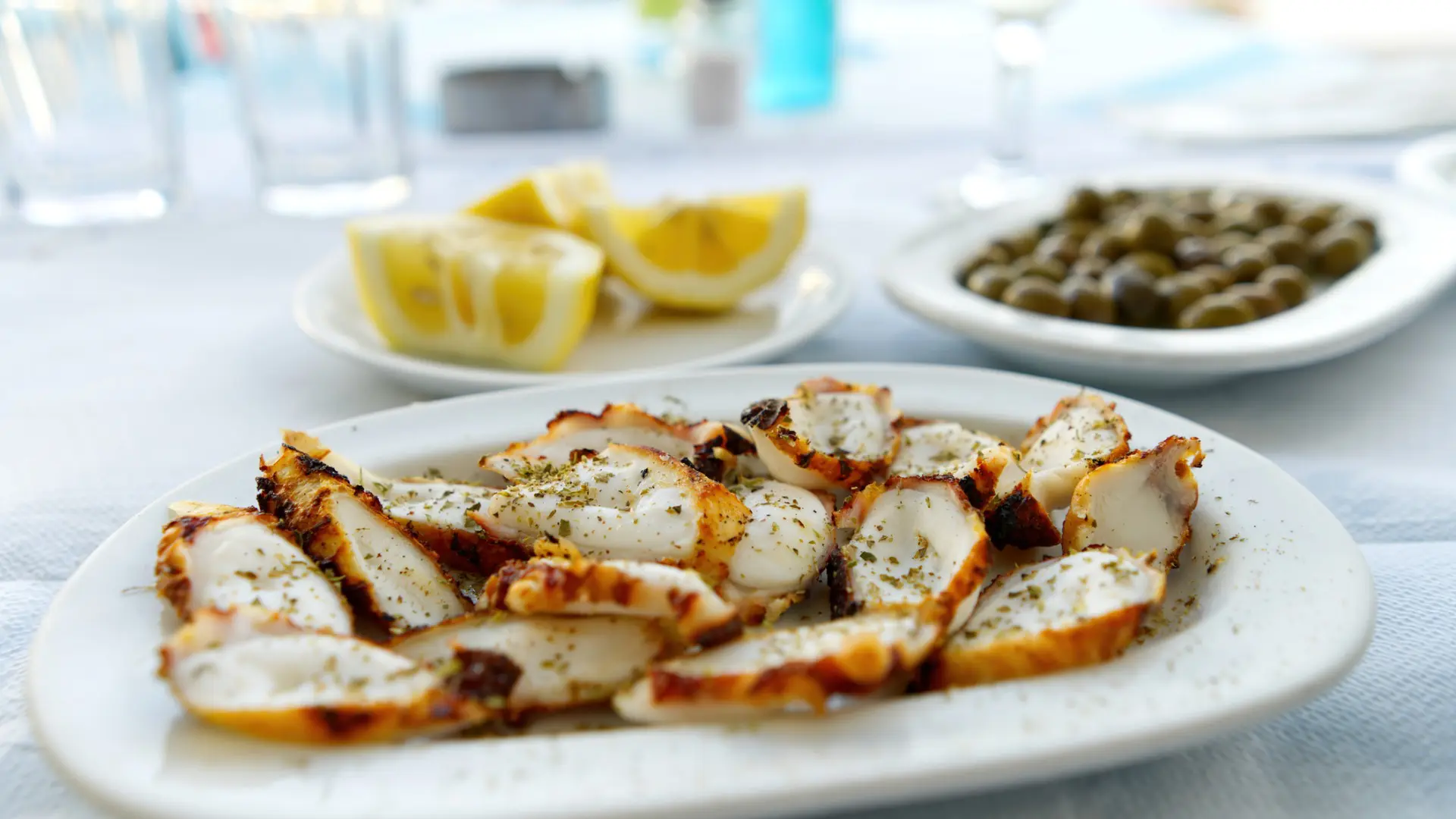
12. Stuffed Vegetables (Gemista)
Speaking of Greek summer, another favorite summer dish is Gemista. The word means stuffed in Greek, and the dish is exactly this: vegetables stuffed with rice, tomato sauce, onions, and herbs, like dill or mint. Sometimes, minced meat is added to the mix.
Tomatoes and green bell peppers are the best vegetables to use for Gemista. Once stuffed, the vegetables are arranged in a baking pan with potato wedges scattered around them.
Gemista are enjoyed either steaming from the oven or at room temperature. Some Greeks even prefer them straight from the fridge the following day.
You can order Gemista as a main dish at most traditional tavernas across Greece. A variation would be stuffed grape leaves, another Greek delicacy that’s mostly served as an appetizer or Meze dish.
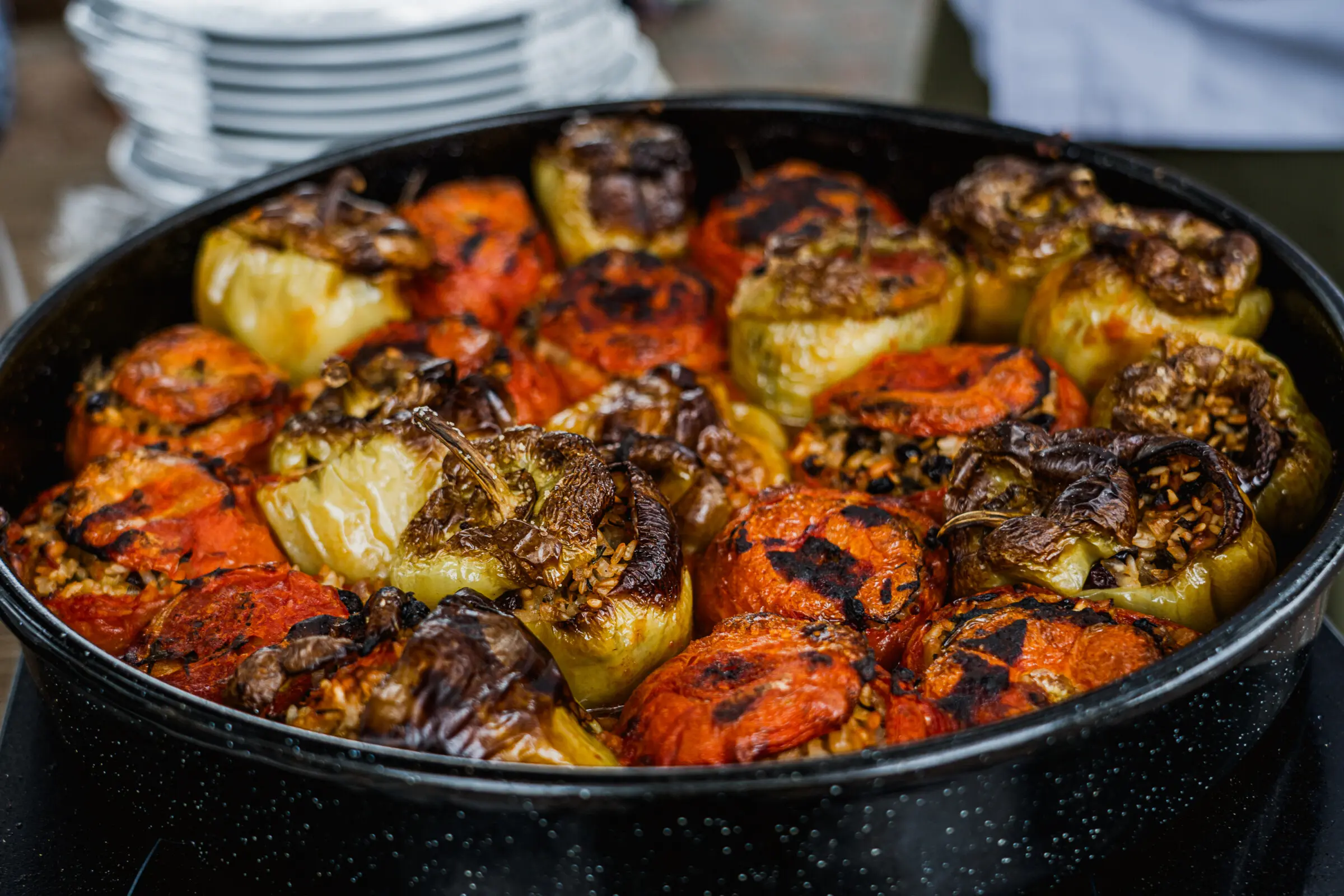
13. Greek Fava
Greek Fava is usually featured as an appetizer on any Greek restaurant menu, but it’s so filling that you can easily order it as a healthy and delicious main meal.
Unlike what its name suggests, Greek Fava isn’t made of fava beans, but yellow split peas that are cooked with chopped onions and then mashed to perfection to be topped with dollops of extra virgin olive oil, dried oregano, more onions, and sometimes capers.
One of the best places to try Fava is Santorini as the island produces the finest yellow split peas in Greece. That said, Fava can be found everywhere in Greece and you shouldn’t miss the chance to try it.
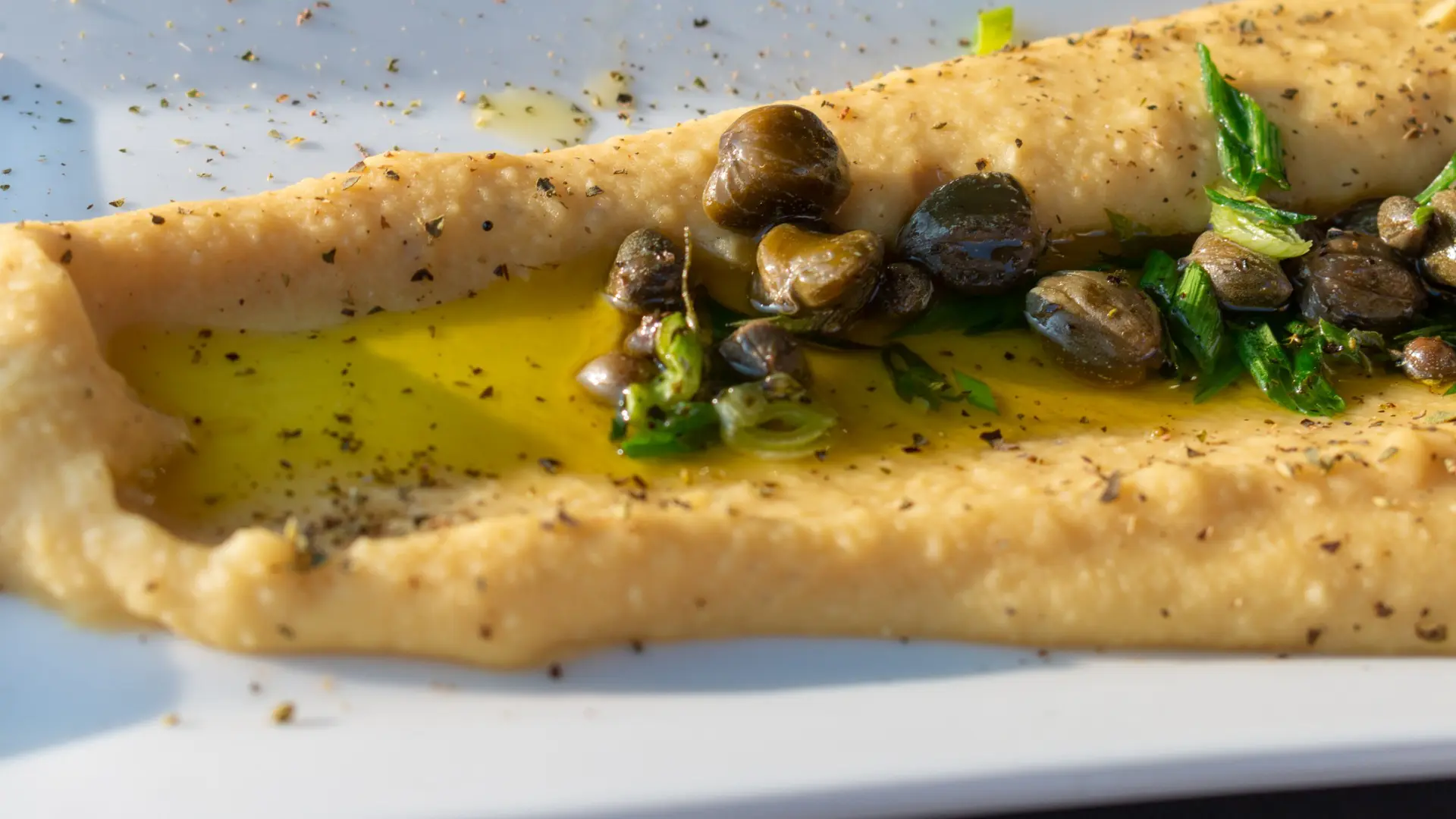
14. Spoon Sweets
This list of the best Greek food could never be complete without mentioning a couple of the most beloved Greek desserts.
Spoon sweets are preserves made of fruit and sugar. In the past, Greeks would make these in the summer, using seasonal fruit, nuts, or vegetables, and keep them in jars to enjoy during the winter.
Back then, offering spoon sweets with a glass of cold water or a cup of steaming Greek coffee was the utmost sign of hospitality. This seemingly simple gesture would also be part of certain event rituals, such as engagement celebrations.
The most common spoon sweets in Greece are made of figs, grapes, quinces, sour cherries, walnuts, cherry tomatoes, and baby eggplant. You can buy jars of spoon sweets at shops selling local products or at the supermarket.
In some traditional tavernas, yogurt topped with spoon sweets is offered as a complimentary dessert.
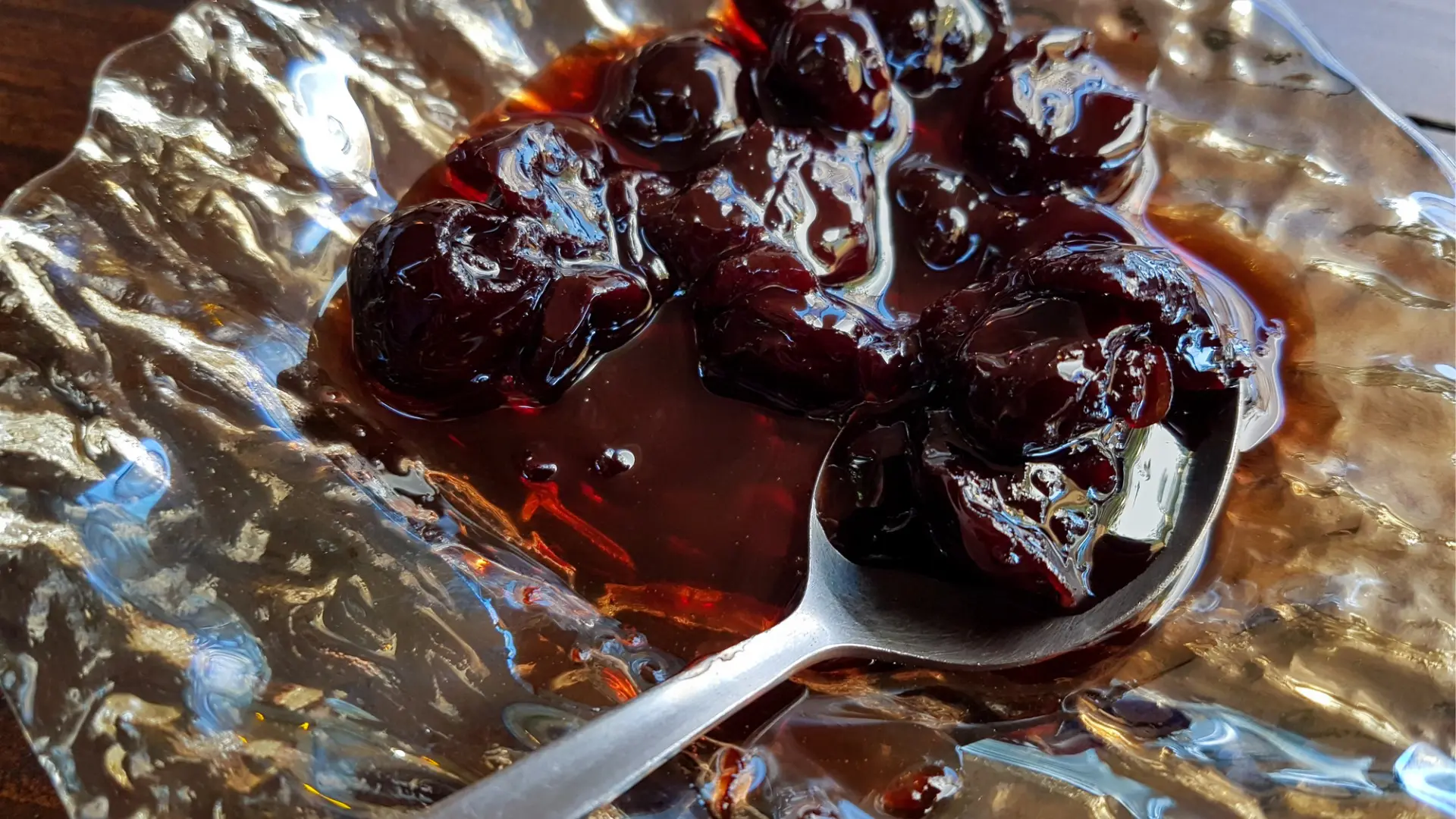
15. Greek Custard Pie (Galaktoboureko)
Way more filling than a spoon sweet, Galaktoboureko is what your sweet tooth will never stop craving once you’ve tasted it.
This traditional Greek dessert consists of several layers of thin filo pastry filled with a rich semolina- or egg-based custard and baked in the oven. The second it comes out of the oven, Galaktoboureko is soaked in sweet syrup and then cut into square pieces.
As you may have noticed by now, there’s a pattern as to what temperature dishes – or, in this case, desserts – should be served in Greece. Therefore, some prefer to eat Galaktoboureko warm while others enjoy it at room temperature or even cold from the fridge.
You can try Galaktoboureko at some cafés in Greece but not all. Instead, you can find Galaktoboureko at any pastry shop in Greece where you can grab a piece or two to enjoy in the peace of your hotel room.

Savor The Best Greek Food With JayWay
No one is judging if you’re planning a trip to Greece just to savor the country’s delectable cuisine – even if you’re not a foodie. Greece is blessed with a mild climate that favors fresh produce while century-old recipes blend with modern twists on traditional staples to create one of the world’s most celebrated cuisines.
On your quest to discover the best of Greece – be it food, beaches, historic sites, or anything else – you have a good friend. Or, several good friends for that matter.
From the author of this best Greek food guide to the Greeks in our trip planning team to our expert local staff in Greece, JayWay is proud to have first-hand experience of Greece.
Nobody is better placed to craft the most memorable Greece itinerary for you than JayWay Travel. So, if you want to experience Greece like a local, tasting the best Greek food at eateries recommended by real Greeks as you go, we’re only an email or phone call away.

Born and raised in Athens, Maria’s passionate about travel and storytelling, a combination that makes her ideal for her role as our content manager.
Maria! Efkaristu! This was the best article on Greek food I’ve read on the internet. It was complete and joyful and made me want to fly back to Athens and Daviki st!!! I shared w all my friends at St. Elias church here in Santa Fe. We have great food celebrations after divine service. Opa!
Hi Yianni! Thanks so much for your kind words, we’re very happy you enjoyed our article about the best Greek food and we do hope you make it back to Greece soon to taste the most delicious Greek dishes again!
“This article is amazing! I love trying new dishes when I travel, and your blog makes it even more exciting. Can’t wait to taste my way through more countries!”
Hi Charles, thanks so much for your kind comment! We’re glad our article helped you work up an appetite for Greek and European food in general!